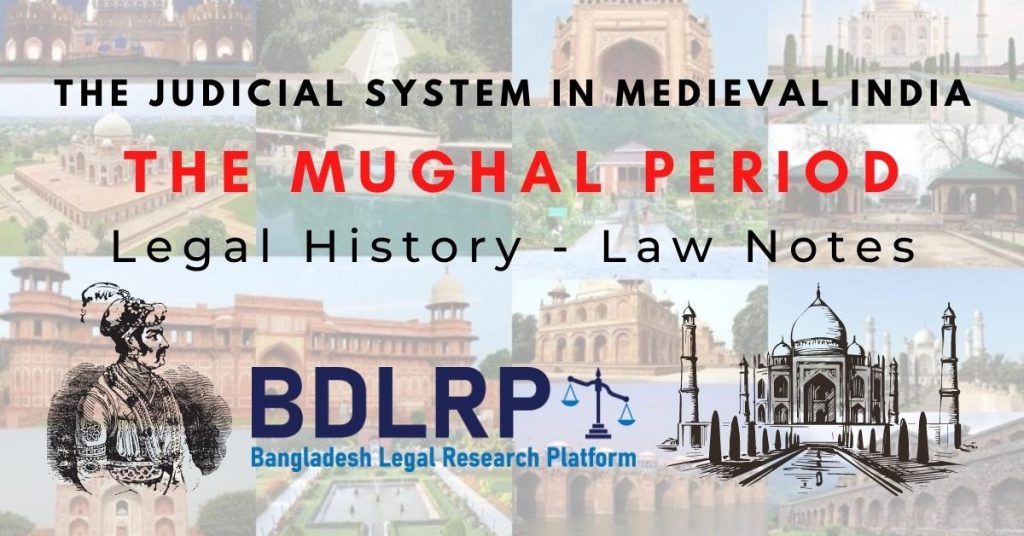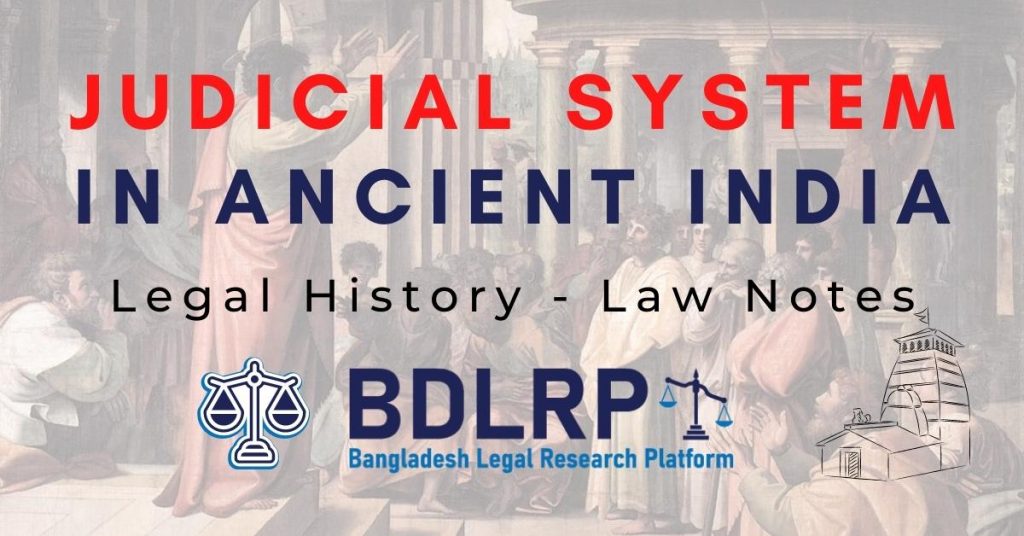Introduction:
The Mughals principles of administration of Justice were mainly foreign and partly Indian. During the Mughal period (1526-1857) the Mughal emperor was considered the fountain of Justice. The emperor created a separate department of justice to regulate and see that justice was administered properly.
Administrative divisions:
The Mughal empire was divided into “Subah”. Which were further subdivided into Sarkar”, “ parganah”, “ Gram”.
Constitution of courts:
There were five courts functioning during this period as follows:-
(a) The Imperial Capital:
Three main important courts were functioning at the capital city of Delhi. They were as follows:
I. The Emperor’s Court: Emperor’s court is the royal court of an empire. The emperor’s court presided over by the emperor himself, was the highest court of the empire. court had jurisdiction to hear both civil and criminal cases.
II. The Court of Chief Justice: This court presided over by the chief Justice was assisted by two Qazies of great importance. This court had jurisdiction to try original, civil and criminal cases and also the provincial courts.
III. Chief Revenue Court : It was the highest court of apple to decide revenue cases.
(b) Provincial Court:
In each province there were following three types of court:
I. The Governor’s Court: The Governor or Nazim presided over this court and he had original jurisdiction in all cases arising in the province. One Mufti and a Daroga-e-Adalat were attached to this court.
II. The Provincial Chief Appeal Court: This court heard appeals from the decisions of the Qazis of the districts. The
power of Qazi-i-subah were co-extensive with those of Governors. This court had original civil and criminal jurisdiction as well.
III. Provincial Chief Revenue Court : This court presided over by Diwan-e-Subah had original and appellate
jurisdiction in all revenue matters.
(c) District Courts:
In each district there were following four Court:
I. District Qazi: The chief and criminal court of the district was presided over by the Qazi-e-Sarkar. This court had jurisdiction to try all civil and criminal matters.
II. Foujdar Adalat: This court presided over by a Faujdar had jurisdiction to try cases concerning riots and sacurity.
III. Kotwali Court: This court presided over by a Kotwal-e-Shahar decided all petty criminal cases.
IV. Amalguzari Kachari: This court presided over by an Amalguzar decided revenue matters.
(d) Parganahs Court:
In each Parganah there were three courts:
I. Qazi-e-parganahs Court: This court had jurisdiction over all civil and criminal cases arising within its original jurisdiction. This court had no appellate jurisdiction.
II. Court of Kotwal: This court decided all petty criminal cases.
III. Amin-e-Parganah: This court presided over by an Amin decided all revenue matters.
(e) Village Courts:
In each village two types of courts were working court of village panchayat and the court of Zamindar. The village panchayat consisted of five persons headed by a headman. No appeal was allowed from the decision of a panchayat. In the late Mughal period, Zaminders courts were empowered to try petty criminal and civil matter.
Appointment of Judges and Judicial standard:
During the Mughal reign, the chief justice and other senior judges were appointed by the emperor himself. Sometimes the chief justice and other judges were appointed directly from among the lawyers. A provincial kazi of high judicial repute was also promoted the post of chief justice. Similarly, provincial and district kazis were
appointed from among lawyers practicing law in the courts. The chief provincial Muhtasib is also appointed from among the lawyers was done dishonest judicial officer were punished and dismissed from service . At the time of appointment the judges were directed to conduct the proceedings honestly, impartially and lawfully.
Institution of lawyers:
The administration of Justice was in the hands of a few officials who were held responsible for any injustice and providing aid to all the residents of the empire.
• Chief Qazi: Chief Qazi was the top judicial officer and was responsible for conducting Justice effectively and efficiently. He was the only judge in religions suits and tried them by Muslim statute. He named the Qazis of the cities, districts, and provinces.
• Mukhtasib: He was the public moral censor. It was his duty to follow the prophets orders and to
suppress all those un-Islamic activities.
• Vakil: The vakils office seems to have taken on prominence when Akbar was a minor and Bairam Khan served as a deputy on his behalf. It slowly lost its importance and faded completely during Shah Jahans reign.
• Kotwal: Kotwals duties are set forth in the book Ain-e-Akbari. He was essentially a city police officer, but in some cases, he was responsible for maintaining law and order in the city, he enjoyed Magisterial power.
Crimes and Punishment:
A systematic judicial procedure was followed by two Muslim Codes namely Fiqh-e-Firoz Shahi and Fatwai-e-Alamgiri. Evidence was classified into three categories –
1. Full corroboration.
2. Testimony of a single individual.
3. Admission including confession.
The court always preferred full corroboration to other classes of evidence. The Muslim criminal law broadly classified crimes under three heads –
a. Crimes against God.
b. Crimes against the king.
c. Crimes against private individual.
Instead three forms of punishments were executed by the court under Muslim law for above three types of crimes.
1. Hadd(fixed penalties): This is the form of punishment which was prescribed by the cannon law and could not
be reduced or modified by human agency. Hadd meant specific punishment for specific offences. It thus provided a fixed punishment as laid down in Sharia for crimes like theft, robbery, whoredom, apostasy, defamation and drunkenness.
2. Tazir(Discretionary punishment): It means prohibition and it was applicable to all crimes which were not classified under Hadd. Offences for which tazir was fixed were all offences against God. It included crimes like gambling, causing injury, minor theft etc.
3.Qisas (retaliation) and (blood money): Qisas meant, in principle, life for life and limb for limb. Qisas was applied to cases of willful killing and certain types of grave wounding or maiming which were characterised as offences against human body. Under Qisas the relatives or successors of the murdered person could excuse the murdered. Qisas become Diya when the next of kin of the victim was satisfied with money as compensation for the price of blood.
Citizenship during Mughal period :
The provision relating to the Citizenship of the people were as follow:
a. None Muslims did not get full citizenship.
b. They were called hostage and were not considered equal to Muslims in law.
c. Their testimony was not admissible in court against Muslims.
d. They were not entitled to enjoy the rights which the Muslims enjoyed.
e. To pay them an additional tax called “Jazia”.
f. In respect of other taxes they had to pay double the rate of Muslims.
Position of Akbar policy:
Mahamati Akbar adopted the policy of tolerance regarding citizenship. He created a single citizenship and adopted a unified justice system for all citizens. He abolished the practice of enslaving prisoners of war, jazia tax and hindu pilgrimage tax. He allowed Hindu and christians to build temples and churches and gave forced converts to Islam the freedom to return to their previous religion. He abolished slavery, the death penalty, forced rape.
Conclusion:
The administration of Justice during the Mughal era was very poor and reached its highest peak during Akbars reign, and its consistency dropped under Aurangzebs reign. We see a strong classification of courts at different levels, but there were no laws to test their working in a loyal Manner. Warren Hastings rightly said “ the Mughal legal system was a very simple and often barbaric and inhuman structure”.
Author: Afsana Afrin
Department of Law and Land Administration,
Patuakhali Science and Technology University (PSTU).





Comments are closed.